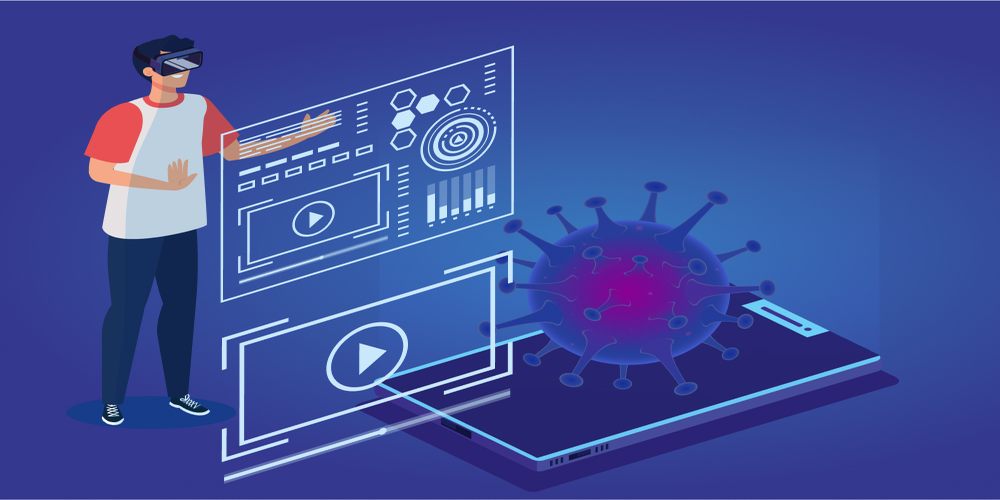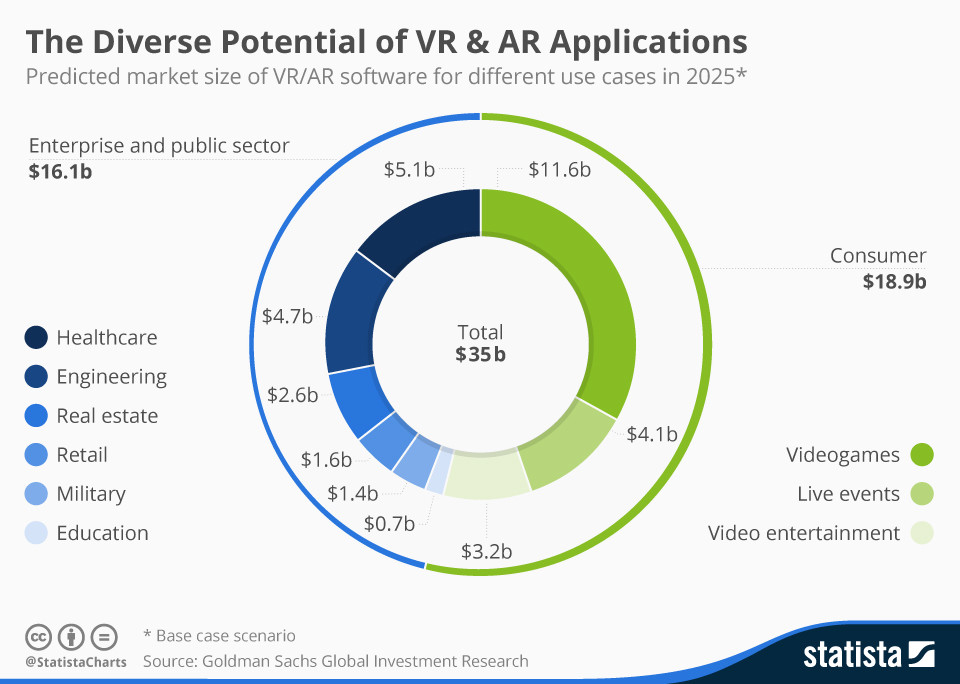How Are Businesses Relying On AR And VR To Survive During The COVID Pandemic?
Virtual Reality | 23-07-2021 | Varun Bhagat

The COVID 19 pandemic has brought the economic activity of all the nations to a standstill, resulting in the deepest global recession the countries ever had in decades. Many countries implemented various forms of lockdown, severely limiting how companies can do business and surging new threats to economic growth.
Probing into this, it's high time when businesses need to deal with uncertainty and unpredictability in creative ways by integrating technologies such as AR and VR into it.
71 percent of consumers say that they would love to shop with businesses that use AR. It makes them more confident about their buying decisions and has the unique ability to communicate every minute detail of the product.

This blog will look at how businesses are embracing trending technologies like AR and VR to mitigate business and social impact while supporting business continuity during the pandemic.
First, let's examine the impacts that COVID-19 and subsequent responses have had on business and society:
The restrictions imposed by the COVID 19 pandemic on individuals and organizations have led to an increase in digital technologies to support various activities like remote work (WFH), digital and contactless payments, online education, online shopping, telehealth, and entertainment.
There are numerous ways in which different business types have been affected by the COVID 19 outcome. Social distancing measures hamper our ability to have traditional face-to-face interactions and often limit groups that we can meet.
The lack of classroom and hands-on training makes it difficult to quickly upgrade new staff skills or train existing staff on products and processes. The potential for virus transmission has made workers reluctant to touch surfaces and objects that others may have touched.
To help address these challenges, new or improved tools and ways of working are required.
AR can play an influential role in mitigating these obstacles while also offering new opportunities to provide long-term business growth.
1. Augmented Reality address COVID-19 restrictions with remote assistance
A critical use case for Enterprise AR is the remote assistance realm. This remote assistance enabled with AR technology helps two or more people in video conferencing, making it entirely different from traditional video conferencing.
It uses computer vision technology to "track" the device's camera movements at the scene.
This allows participants to add annotations that "stick" to the scene's elements and therefore remain in the same place in the physical world as seen by users. Here, annotations mean redlining or other simple graphics. This use case will help in mitigating or eliminating the impacts of reduced travel, downsizing of staff, and social distancing.
2. AR-enabled remote assistance for medical equipment procedures
Sarah Reynolds, Vice President of Marketing at PTC, comments: "As organizations seek to maintain business continuity in this new normal, they love the AR technology to address travel restrictions, social distancing measures and other challenges that affect the capacity of the front-line workers to go on-site, operate, maintain and repair machines of all kinds.
Even when product or equipment experts can't address technical issues in person, AR-enabled remote assistance allows them to connect with on-site employees and even end customers to provide contextualized information and expert guidance, helping them resolve these problems quickly.
3. AR in medical equipment training
Medical professionals use AR for providing interactive and efficient training methods to the new joiners. This process makes it easier for beginners to learn new equipment and other important procedures.
The marketing and communication manager at REFLEXT, Harry Hulme, says that healthcare workers see AR as the best tool during these testing times as it reduces the risk of human error and reduces the training and onboarding time.
Now that we are done with the benefits of AR in business, have a look at the VR benefits in covid for businesses.
The coronavirus's main concern is personal and family health during this time. But the business impact has also been substantial, from lowering financial projections for Microsoft and Apple to canceling major conferences like Mobile World Congress and Facebook's F8.
It is, therefore, no wonder that companies and governments can and are taking advantage of virtual reality during the coronavirus outbreak to function better. At InstaVR, we discuss the top business changes driven by the widespread adoption of VR.
Next, we'll take a look at some of the most impactful use cases for virtual reality during a health event like this.
The major benefits of virtual reality are immersive, memorable, and the closest thing to "being there." As the coronavirus has necessarily caused isolation and informed travel plans for many, virtual reality takes over. Activities that previously required an "in-person" presence can now be performed virtually.
However, there exist several use cases of VR in mitigating business risk, but here I will list the one which companies and government will find the best among all.
1. Remote employee training with virtual reality
In recent years, companies were already accelerating their adoption of virtual reality to train their employees. With this, you save money while quickly scaling to deploy hundreds or thousands of workers.
However, the coronavirus has prevented some workers from traveling, such as coaches and corporate managers. Recording and implementing 360-degree virtual reality training, whether for virtual reality headsets, mobile devices, or WebVR, enables employees to obtain virtual training without even leaving their geographic location.
Virtual reality training can help ease the burden of onboarding new employees, who may temporarily take care of workers affected by government actions related to the virus. For example, Japanese Prime Minister Shinzo Abe has called for Japanese schools to close during March. Parents who can't get back to work because of this issue can easily use VR-enabled apps to learn all the job details.
Companies like Apple and Microsoft also have to look for supply chain options outside of China now. Many of the warehouses in other countries that they could use would have to be mobilized quickly.
There is no alternative to it rather than using 360-degree virtual reality experiences for supply chain management.
As a matter of readiness, all companies should capture their essential process in 360 / VR if they need to replicate it.
With InstaVR, you can train multiple employees simultaneously, regardless of their location.
Businesses can make your VR apps in minutes, and more than 50,000 thousand companies and professionals have relied on InstaVR for developing their apps. Industries that have been catered by InstaVR are real estate VR, tourism VR, and automotive VR.
The coach or corporate manager would not have to travel to the affected regions and still lead training. Virtual reality training makes perfect sense in a world with travel limitations.
2. VR in real estate
One of the most affected sectors that have been stormed by the COVID-19 pandemic is real estate. People can't step out of their homes to see the real estate industry and housing market.
With the help of VR, landlords and real estate agents can use VR technology to show the virtual 3D tour of flats and apartments in the market. Not only, the renters and buyers can have a virtual tour of the homes; they can also have paperless and sign-in contracts to have online transactions.
3. VR for tradeshows and events
Quarantining at home has caused great harm to the tradeshow industry. Many exhibitions and conferences have been canceled worldwide, affecting the other chain of industries, including hotels, airlines, and restaurants.
By incorporating AR and VR into these tradeshow events, participants can join from many countries as it will help them save their travel time, meal cost, and other expenses. Experts believe this technology will stick even after the fear of COVID19 passes away as it invites a large number of speakers and participants to participate.
So, the industry can see a positive change post-pandemic, thanks to these two wonderful tech stacks.
So, what's next?
So, here we discussed the ways by which AR and VR are helping in mitigating business risks despite the COVID restriction changing the way professionals live and work. With the implementation of AR and VR in businesses, we can see that no business can stop working just because of remote working.
And this is possible only because of the technologies AR and VR. The use cases of these two tech stacks are endless, and if you are one of those entrepreneurs who is looking to integrate AR and VR into your application, hire augmented reality developer or a VR one to see how its implementation changes the ways you and your employees work.

.jpg)

.jpg)
.jpg)
.jpg)
.jpg)
.jpg)


